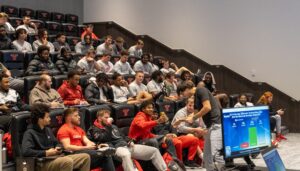In today’s rapidly evolving world, equipping college students with essential financial literacy skills is paramount which is why it’s crucial for administrators to understand the optimal strategies for implementing a university personal finance program. To ensure the success of a university personal finance program, the rollout strategy holds the key. A successful implementation hinges on maximizing participation, fostering engagement, and ultimately driving meaningful outcomes. In this post, we’ll delve into the strategies to effectively launch and sustain a personal finance program that resonates with students.
The Power of Participation, Engagement, and Outcomes
Success in any financial literacy program for college students is rooted in the triumvirate of participation, engagement, and outcomes. The sequence of these three factors plays a pivotal role. By first reaching as many students as possible, the groundwork is laid for broader impact. Engagement then becomes the major focus to ensure that attendees are actively participating throughout the program whether it’s a 60 minute workshop or semester long course. Engagement is the precursor for the ultimate goal of driving positive financial outcomes. The goal is to not only educate students about personal finance but also empower them to make informed financial decisions throughout their lives.
The Required vs. Optional Conundrum
When the personal finance program is mandated for all students, participation is inherently higher. Show up or else there are consequences. However, the challenge lies in maintaining engagement when a program is required. The program must transcend being a mere obligation and evolve into a captivating experience. Transforming disinterested attendees into enthusiastic participants should be the primary objective for all required programs.
On the other hand, if the program is optional, its success pivots on strategic marketing and a meticulous rollout plan. Countless well-conceived personal finance initiatives have faltered due to inadequate publicity and low attendance. To mitigate this, consider leveraging existing student meetings, clubs, or activities to reach more students. Integrating your program seamlessly into students’ schedules and organizations can bolster its acceptance and long-term impact.
Navigating Existing Structures
Creating an entirely new event can be daunting. It requires additional approvals and often times involves additional administration and sign-offs that can create more work for the organizers. Instead, consider integrating the personal finance program into pre-existing programs or your existing work with students in order to reduce the amount of additional work. This approach eases the burden on organizers and administrators, as participants are already accustomed to the routine and atmosphere of a pre-existing organizations and meetings. Minimizing additional work for all parties involved is a key determinant of the program’s triumph.
Incentivizing Engagement
To keep students engaged and boost attendance, incentives play a pivotal role. Whether required or optional, integrating rewards like free food, merchandise, or other enticing perks can be a game-changer. These incentives not only lure participants but also sustain their active involvement throughout the program.
If you aren’t sure where to start with incentives ask students directly and pay attention to the incentives that other successful programs use around campus.
Tying Outcomes to Key Metrics
Ultimately, the success of your personal finance program is tied to students taking actions that lead to desired outcomes. These outcomes are closely intertwined with the number of attendees and the depth of their engagement. Positive actions should be incentivized through rewards, reinforcing the idea that financial literacy is not just a theoretical concept but a practical skill to be mastered. Leaving students with actions and showing students that they will have success is a great tool to drive attendance and reinforcing the effectiveness of the program.
Wrapping Up Implementing a University Personal Finance Program.
In conclusion, implementing a university personal finance program is a multifaceted endeavor that requires a strategic approach. Balancing participation, engagement, and outcomes forms the foundation, whether the program is mandatory or optional. Integrating with existing student structures and employing incentives can enhance both attendance and engagement. By following these strategies, your university can roll out a personal finance program that leaves a lasting impact on students’ financial well-being.
Additionally, Ostrich has turnkey personal finance programs for universities.














